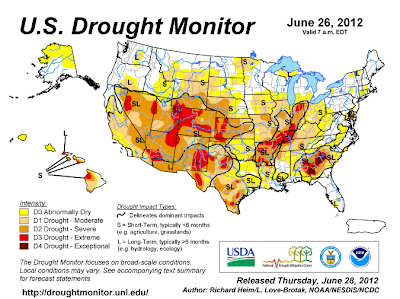The average temperature was 73.6ºF, 3.9ºF above the 1971–2000 average. Using the evaporative cooler or air conditioning a lot? We had 301 cooling degree days, 114 more than average.
Although a bit simplistic, the Palmer Drought Severity Index uses rainfall and temperature to evaluate drought severity. Using this index, the US Drought Monitor presently classifies Utah as being abnormally dry or in extreme drought depending on location.
 |
| Source: http://droughtmonitor.unl.edu |
A non-scientific assessment might classify the current situation as crispy.

Do you find it odd that the record dry streak was Sep-Nov? I would've thought that it would have likely occurred a few months earlier, given the summer climatology of upper-level ridging. Oh well, maybe we'll change that...
ReplyDeleteWhat was the difference climatologically 50,000 to 30,000 years ago compared to present time that allowed a much wetter climate here in Utah?
ReplyDeleteLooking at the list it appears that the longest dry periods for SLC are somewhat bi-modal, mostly either early-mid summer, or in the fall. This makes some sense since early summer has a strong climatological precip minimum centered about the beginning of July. In autumn there is commonly strong ridging also, and after mid September there is usually a lack of convection associated with these ridge situations. Also many cold frontal passages that occur in Sept/Oct are dry fronts as the storm track is relatively far to the north.
ReplyDelete